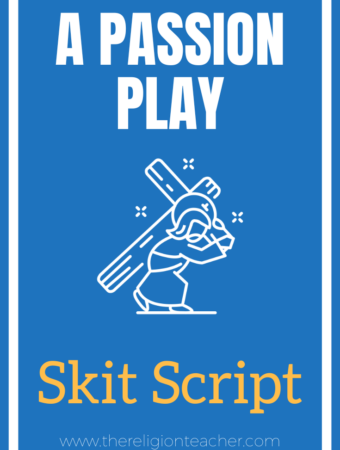
If you watched the last video in this series, then you know some of the biggest mistakes we make as religious educators. We spend more time than we should lecturing in front of the class. We spend time reading the textbook out loud even though the kids aren’t following along. And we assign busy work like word searches and coloring sheets that keep kids quiet but not engaged in learning about their faith.
Watch Part 1: 3 Mistakes to Avoid This Year
These mistakes make us ineffective as educators and pretty overwhelmed and exhausted when the students are not engaged. We end up working harder than we need to because the kids just aren’t that interested.
So what do we do instead?
We focus all of our energy and preparation on keeping the students active–more active than we are–and engaged.
Here are a few ways to make that possible:
Watch the Video
1. Graphic Organizers: Try Active Listening and Reading
OK, maybe I’m asking too much? Maybe lecturing and reading the textbook out loud is essential at some points. After all, we need to introduce new ideas somehow, right?
Here is what you can have your students do while you speak or read. (Remember, though, just don’t talk for too long.)
Keep your students listening actively with “graphic organizers.”
Graphic organizers may look like plain old worksheets, but they are much more than that. A graphic organizer is a visual way to represent information. It helps the brain process and understand ideas.
As you lecture (or read) have the students take notes in a specific way. Have them write down what you are talking about in a worksheet that visually represents the ideas you are saying.
Why does this work? Because our brain acquires knowledge by making connections between old ideas and new ideas.
Here’s what the neurons in our brains look like:

Notice how each neuron is connected almost like a web with other neurons? That’s how the brain works. It makes connections between one idea and the next.
Graphic organizers provide a visual way to make connections between ideas.
Now, here are some graphic organizers to give to your students to help them process and understand new ideas as they listen and read. Use them to craft your lecture notes or take notes on the books.
Download the Graphic Organizers
2. Practice, Practice, Practice!
Here’s the other approach that I find works incredibly well.
Practice is essential for any endeavor–whether in sports, arts, or work–and we should do it in religious education too.
Here is a basic summary of what effective teaching and catechesis looks like:
Present –> Practice –> Check (repeat)
(Diagram taken from session 4.3 of the Classroom Engagement Course.)
Teach: We present new ideas with a very brief, well-organized lecture, or video, or reading.
Practice: Then, the students practice and apply the new ideas they have learned in some way.
Check: Finally, we check to make sure they have understood and effectively applied what they were being asked to learn.
What can you do during the “practice” phase?
Find or design activities that reinforce what they learned and find high-quality worksheets that challenge students to think.
Keep Kids Active with Centers
I have found that one of the best ways to practice and give the students the kind of one-on-one attention the students need most is something called centers.
Centers are essentially designated stations (places) within your classroom where a student goes to do an activity.
Here’s how you set them up:
Step 1: Pick three (or more) activities, worksheets, graphic organizers, etc. for students to do that will help them apply what they have learned.
Step 2: Print out or make copies of the directions and necessary materials for each activity/worksheet.
Step 3: Place the directions and materials for each of these activities/worksheets at designated areas throughout your room.
Step 4: Divide your class into groups and assign them to each station.
Step 5: Give the students 10-15 minutes to complete each activity. Then, when the time is up, have them go to a different station.
Bringing It All Together
When things are all said and done, then, how do you teach?

You might present a short lecture on the topic of the day with the students taking notes using a graphic organizer. I suggest limiting it to just three main ideas (just like Pope Francis).
Then, you can break the students up into groups and have them work on activities and engaging worksheets in their centers while you walk around helping students individually or in groups that need help.
Finally, you can check for understanding of the ideas at the end of the lesson.
This, I have found, is the most effective way to structure the educational/catechetical portion of your class. It maximizes your class time and keep the students focused and engaged.
Whether you are just starting out or a little more experienced, using graphic organizers and thought-provoking worksheets can be a great way to make sure students are active and engaged.
——
Once you start teaching in this way, the question becomes: where do I get high-quality activities and graphic organizers to keep my students engaged?
Well, this is why I founded The Religion Teacher and the accompanying membership website.
In the meantime, start experimenting with graphic organizers and try to use centers in your classroom. Get used to the process and practice, practice, practice.




My junior high students want to do the Corporal Works of Mercy. Since September they and their parents have worked at our local Interfaith Homeless Network program and baked and sold cookies to buy socks for St. Vincent de Paul and the local program mentioned earlier. Our Advent project was the cookie baking on Saturday and sale after Mass on Sunday. Kids and families loved it! We will do this again for Lent. We only meet twice per month on Sundays, so I am struggling with formal teaching. I want the class to write and illustrate one page each on Jesus’ ministry for a book to give our First Communicants in May. I am thinking that I can use stories of Jesus in these graphic organizers. The kids can pick one each week and work on it. Tell it, illustrate it and say what it means to them.